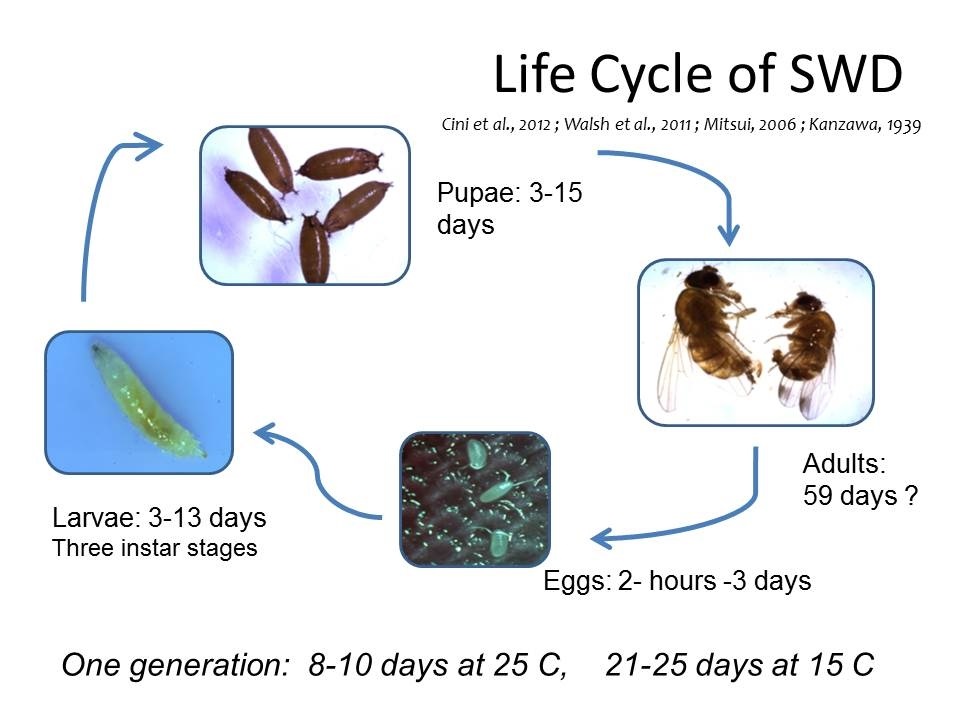Biology of the spotted wing drosophila
Learn about the life cycle of the spotted wing drosophila (SWD), an invasive vinegar fly native to southeast Asia.
Introduction
Spotted wing drosophila (SWD) is an invasive vinegar fly native to southeast Asia. It is a pest of soft-skinned fruit. SWD females are able to lay eggs in undamaged fruit before harvest due to a large, serrated ovipositor that is not normally present on other common vinegar fly species. Therefore, larvae may be present in fruit at harvest, reducing fruit quality and yields. Additionally, the oviposition wound acts as a pathway to secondary infection by other insects and pathogens causing rapid deterioration of the fruit. SWD are of concern as they have recently invaded the U.S., Canada, and Europe, causing fruit damage and revenue loss.
Life cycle
Since SWD has only recently been found in Ontario, our knowledge of their biology is based on information from southeast Asia and western North America, where they have been established for a longer period of time. Research is underway to gather information more specific to SWD in Ontario. However, it is known that SWD have a life cycle containing an egg stage, 3 larval instars, a pupal, and an adult stage. Eggs, larvae, and pupae are present inside the fruit. Full development from egg to adult can take between 8 and 25 days depending on temperature (Figure 1).
The adult lifespan can vary between 3 and 9 weeks, although overwintering adults that emerge in late autumn can survive until the following spring by seeking refuge under leaves, between stones, or in man-made enclosures. Most SWD move to sheltered locations outside of crop fields to overwinter. Overwintering SWD enter a state of reproductive diapause and are then able to lay eggs the following spring. Females reach sexual maturity 1 to 2 days after emerging, with the ability to produce anywhere from 380 to 560 eggs in a lifetime. Populations peak in late summer and early fall. The preferred temperature for SWD is between 20 and 25 °C, and their activity is reduced when temperatures exceed 30 °C or fall below 10 °C. Given this information, it is predicted that SWD will be able to complete 3 to 9 generations in the Canadian growing season.
Crops affected and wild hosts
SWD has a wide host range but is primarily a pest of soft-skinned berries and stone fruits. They can infest cultivated crops and wild hosts that may border crops. If perimeter hosts are left unmaintained, populations may increase as SWD adults move from host to host with different ripening times. Late season crops are at a higher risk of infestation because populations peak after late July, however early crops can also be affected. Crops of concern include: strawberries, blackberries, blueberries, cherries, raspberries, elderberries, mulberries, nectarines, peaches, pears, and plums and possibly grapes. Wild hosts include: buckthorn, dogwood, brambles, nightshade, honey-suckle, black elder, pokeweed, and pin cherry. SWD have been found to feed on oak tree sap, and oviposit on cracked or damaged tomatoes, and even flowers in the absence of ideal hosts. This is an indication of their opportunistic behaviour.
Observations in Ontario
The first detection in Ontario was in November 2010. In 2011, SWD adults were not trapped until the middle of August, and numbers did not increase until late September. No commercial damage was reported.
In 2012, the first SWD were trapped on June 25th. Larvae were detected in fruit as early as July 6 and widespread damage was evident in mid-late August. Since then SWD has been trapped each year in early to late June in early regions and is generally present throughout Ontario by mid-late July.
Studies on SWD in their native range of Japan suggest that this species can survive and overwinter in below-freezing conditions. It is important to monitor the activity of adult SWD each year to determine when the pest is active. The risk to early-developing fruit crops, particularly early varieties, could vary from year to year, depending on overwintering conditions. All growers should be prepared to control SWD each year.
More information
- For more information on monitoring for SWD adults and larvae see:
- Links to information from other sources:
